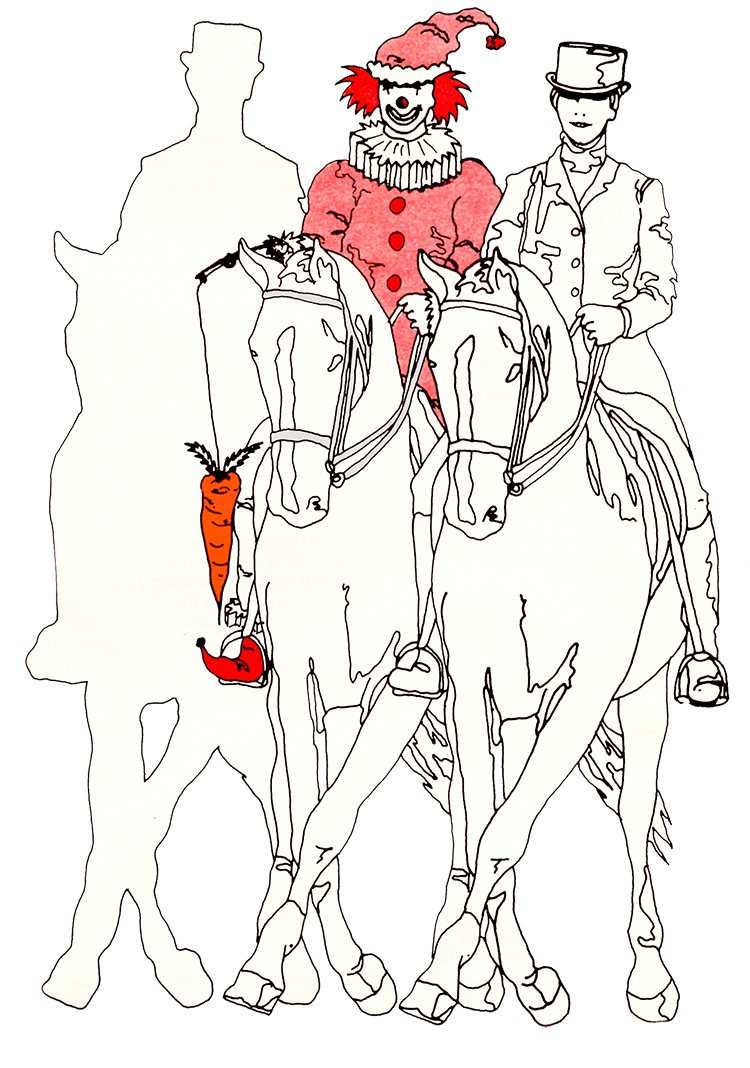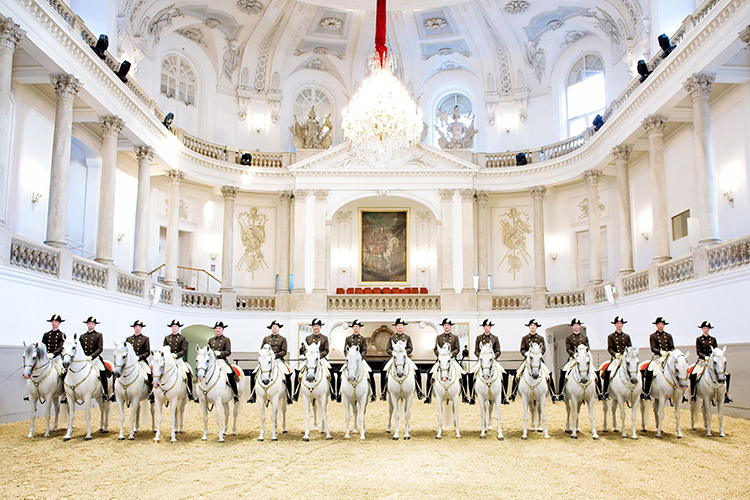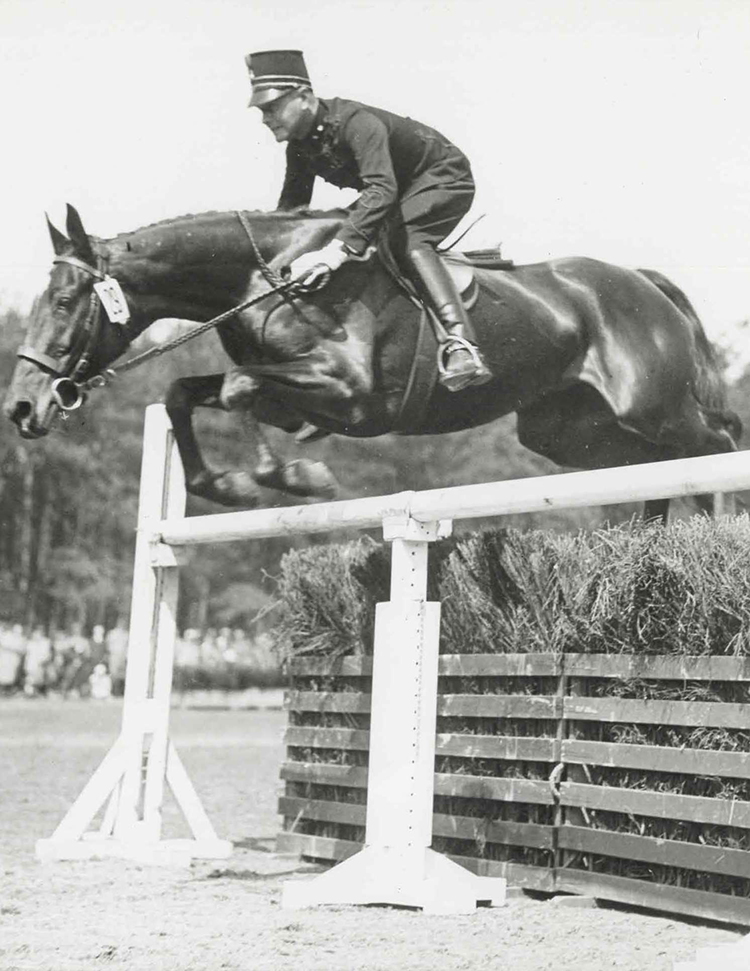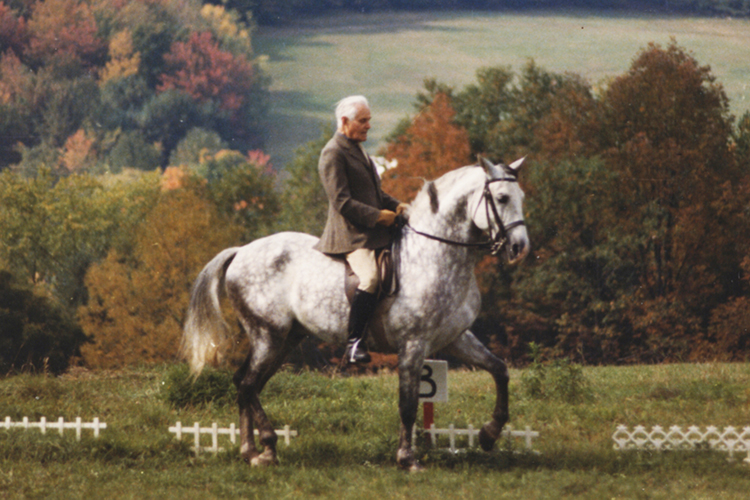Henri van Schaik was a welcome contributor (and witty correspondent) to The Horse Magazine, throughout the 80’s. When he died in 1991, the dressage world lost one of the great defenders of the classical tradition…
This article first appeared in October 1987.
 Perhaps no innovation has aroused more spectator enthusiasm than Dressage to Music. The Kür, and the Championship of the Kürs, the Nashua World Cup has captured the imagination of Europe – but there are many respected dressage authorities who are worried, gravely worried at the threat to the Classical Principles. Dr H.L.M. van Schaik takes a searching, and highly critical, look at the modern competitive Kür…
Perhaps no innovation has aroused more spectator enthusiasm than Dressage to Music. The Kür, and the Championship of the Kürs, the Nashua World Cup has captured the imagination of Europe – but there are many respected dressage authorities who are worried, gravely worried at the threat to the Classical Principles. Dr H.L.M. van Schaik takes a searching, and highly critical, look at the modern competitive Kür…
Some time ago, I read in the American magazine, Dressage & CT, several quotations from the International Dressage Rider’s Club Bulletin. There were some interesting remarks made by Christopher Bartle and what interested me in particular was his suggestion that three competitions should decide the order of placings in the World Cup. I have done a lot of thinking about Bartle’s ideas, and I have come to the following suggestions.
From what I saw on video of the last World Cup, I think that the performances were very bad. As a result my thoughts go in the following direction:
The first competition should be a test to check that the basic gaits are correct; in other words, that the horse has learned all the movements such as transitions, leg-yielding on the circle, shoulder-in on the straight, to improve the skills that will enable him to correctly execute movements such as renvers, half-pass, flying changes, pirouette, etc.
It should also check that the position of the rider and the application of the aids are impeccable. This should be a test on a level of what Seunig calls the ‘Niedere Kampagneschule’*
Since no extended gaits would be asked, the arena could be 20 x 40. A score of at least 60% would admit the rider to the second competition, this one would be at the level of what Seunig calls the ‘Hoehere Kampagneschule’*. In this test, extended gaits would be asked for, therefore the dimension of the arena should be 20 x 60. A minimum score of 60% would admit the rider to the Kür.
The Kür is the opportunity the rider has to show classical equitation in all its beauty. Therefore no boring movements such as walk, halt, rein back, turn on the haunches are required – that the horse is able to do these movements has already been shown in the first test. The extended gaits have been shown in the second test. The extended canter has a danger, as was demonstrated in Cedar Valley, where the young German, Sebastian Heinemann, ended his Kür with a gallop at breakneck speed with a sliding halt.

Some of the riding at Cedar Valley seems to bear our Dr van Schaik’s concerns…
The audience was wild with enthusiasm and later booed the judges for placing him second. Maybe it is good business, but it was not classical equitation.
Because there are no extended movements in the Kür, the size of the arena can be 20 x 40. Failed piaffe, passage, pirouettes or flying changes, should entail elimination. This is of course a very rigorous suggestion, but I think that it is the only way to save classical equitation.
If I am correctly informed, the FEI hesitated to accept the Kür, because of the possibility that it would become a circus. I am afraid it has become one. What I saw in Cedar Valley, during the World Championships, was a mockery of classical equitation. What I saw on the video and what I read in German and French reports about the World Cup, during Equitana, was even worse.
After I read an article that Max Ammann wrote in the June 1987 issue of Horse Show, I think that the FEI had reason to hesitate to accept the Kür, and although I am a firm believer in the idea of the Kür, I regret that the FEI ever did accept it.
Since Max Ammann is one of the promoters of the World Cup, and since he makes no bones about the fact that for him, the World Cup is business, his main concern therefore is to please the public. He writes:
“In this connection, it might be said that Dressage has a self chosen habit that weighs very negatively: namely the fact that the winner usually ends up with a 70%. In comparable sports, such as gymnastics, or figure skating, the winner ends up with a score somewhere between 95 and 97%… In Dressage, the riders compete against a phantom… By judging the present against an unattainable ideal, we block in effect public acceptance of dressage…“
It seems to me that we are in a pretty sad situation when somebody in the position of Max Ammann claims that classical equitation is a phantom and that therefore the judges should give higher marks. It is my opinion that the quality of Dressage is maybe at an all time low, because of the mentality of the era in which we live. Everything has to go quickly; we take shortcuts and we do not take the time to learn to understand what the schooling of a horse is all about. On top of this we use drugs to camouflage unsoundness; hand in hand with this, we see an increasing use of force, bordering on cruelty. For the culprits, I have this quotation from Nuno Oliveira:
“If it is necessary to use force, then we enter a domain that does not belong to the Equestrian Art, neither for that matter, to the circle in which civilized people dwell.”
All this is a reason why I suggest this three phase competition. By doing this, the high level riders would be forced to show that the basic education has been sound and that the horse has been gradually developed to the highest levels. These are, of course, just thoughts and should be scrutinized and worked out.
 Another problem with the Kür is the music. There are different opinions about what the function of music during a Kür really is. During the performances of the Spanish Riding School, it is mainly background music. In opposition to this, there are those who think that the music should accompany the ride, having the same beat as the movements of the horse. This results most of the time in editing different compositions in order to stay with the beat of the trot or the canter. Most of the time this editing is an artistic failure.
Another problem with the Kür is the music. There are different opinions about what the function of music during a Kür really is. During the performances of the Spanish Riding School, it is mainly background music. In opposition to this, there are those who think that the music should accompany the ride, having the same beat as the movements of the horse. This results most of the time in editing different compositions in order to stay with the beat of the trot or the canter. Most of the time this editing is an artistic failure.
Because of the fact that the walk is a movement with practically no impulsion it is very difficult to find fitting music. On top of this it is very boring to watch. This is the reason why I think that the walk should never be asked for in a Kür.
I think that classical equitation should be accompanied by classical music. The music should be festive, not a farce; neither do I think that vocal music is appropriate, and speech or address by the rider should entail elimination. Classical Equitation is a heritage of the Old Masters, let us preserve it and not squander it.
*The German expression ‘Kampagneschule’ is a conception for which there is no adequate translation in English. The element ‘Schule’, school, means the program every young horse has to go through in order to make him physically and mentally fit, so that he can be ridden. The element ‘Kampagne’ means that the aim of the schooling is to get a horse that is able and willing to take his rider on the trail, across fields and do a little jump. This is the ‘niedere’ Kampagneschule, the requirements of which would roughly correspond with our third level. In the ‘hoehere Kampagneschule’ the requirements are about fourth level and Prix St Georges.
 Dr H.L.M. Van Schaik
Dr H.L.M. Van Schaik
1899-1991
Henri van Schaik was born in Holland and began his riding career as a showjumper, winning team silver at the Berlin Olympics on Santa Bell.
He migrated to the United States after WW2, and opened a riding academy in Vermont. He was much in demand as a trainer and a judge, as respected as a rider who trained in the classical manner.
Throughout the 60’s, 70’s and 80’s, he was one of a number of riders who became concerned that the classical principles were increasingly under threat from the emerging style of competition dressage.
His book, Misconceptions and Simple Truths in Dressage began as a series of articles defending the classical way of training. Writing in Dressage & CT, after the World Dressage Championships in Canada, he was withering:
These last World Championships made it very clear that the judges totally neglect the artistic. This was also evident in the judging of the Kür. I am convinced this is the reason why classical equitation is practically dead. It was expressed very well by somebody sitting in my neighborhood: ‘The quality of the horses is getting better and better, but the level of riding is going consistently down.’
I saw only two horses who made the impression of doing of their own accord what was required of them. Their riders, although not very good ones, both had very soft hands. It all made an effortless impression, both riders and horses enjoying themselves. They were, of course, very low in ratings.
High in the ratings were riders with very active hands, interfering almost every stride. One of the riders during the Grand Prix Freestyle, used her hands as the conductor of an orchestra does. Every beat of the music brought her hands up.

Some riders were very mobile with their bodies especially in the extended canter. I cannot understand why the judges do not do anything about it. This way of riding is a mockery of classical equitation and against the rules.
The reason that so many people have trouble with their hands is that they use the wrong muscles. The contact with the horse’s mouth should be elastic. This can only be achieved if the rider flexes the elbow, never riding with stretched elbows, and also if he does not use the arm muscles, with the exception of the triceps. The rider should be able to balance the hand, which he cannot do if he uses his biceps or lower arm muscles.
The rider should resist with his back muscles. Before the Second World War, people were taught to ride with their back, not only to create impulsion but also to resist. Nowadays, most people pull with their arms, often brace their hands and they try to create impulsion with their heels and spurs. Their legs are all over the place, most of the time.”
Dr van Schaik died in 1991, and was spared the most unpleasant features of spectacular dressage, but then again, he missed the revival of civilised riding with Carl and Charlotte, I think he would have enjoyed them.
– CH



